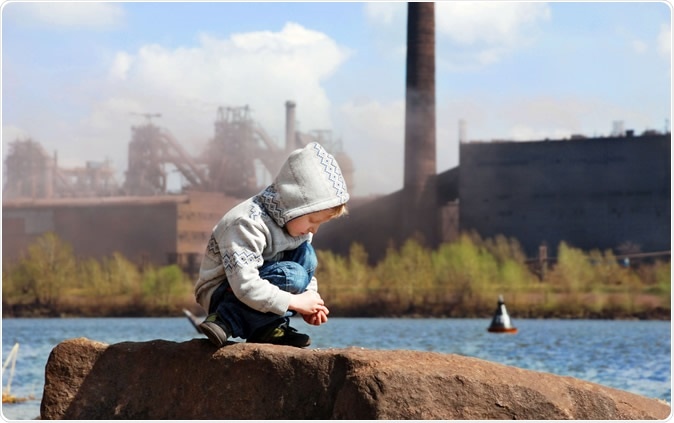Air pollution has far reaching effects and a new study shows that each year there are four million new cases of childhood asthma across the world attributed to air pollution. Researchers say that this roughly translates to 11,000 new cases of childhood asthma being diagnosed daily. The results of the study were published in the latest issue of the journal Lancet Planetary Health.

Image Credit: Soloviova Liudmyla / Shutterstock
The researchers explain that in China and in India, the levels of air pollution are among the highest. However childhood asthma cases seem to be rising even in regions where the pollution levels are well below the recommended limits from the World Health Organization (WHO). This goes to show that even lower levels of air pollution is associated with childhood asthma say the experts.
They add that traffic in the UK, the US and Canada contributes to a quarter of the new childhood asthma cases. Canada for example comes third in the list of 194 countries with traffic associated childhood asthma cases. South Korea tops the list of nations with highest traffic related childhood asthma incidence. Other nations featuring within the top ten include Japan and Belgium and six Middle Eastern nations such as Saudi Arabia. Among the cities, both New York City and Los Angeles feature among the top 10 worst cities out of the 125 analyzed.
The top three nations that have highest rate of childhood asthma linked to air pollution are;
- China with 760,000 annually
- India with 350,000 annually
- US with 240,000 annually
- Indonesia with 160,000 annually
- Brazil with 140,000 annually
The experts believe that chronic exposure to the toxic fumes of air pollution is leaving the lungs of these children stunted in its growth and development. Prof Susan Anenberg, at George Washington University in the US in a statement said, “Our findings suggest that millions of new cases of paediatric asthma could be prevented by reducing air pollution.” The team says that the main pollutant in the air is nitrogen dioxide that comes from the diesel vehicles. “Improving access to cleaner forms of transport, like electrified public transport, cycling and walking, would reduce asthma, enhance physical fitness, and cut greenhouse gas emissions,” added Anenberg.
This latest study looked at the nitrogen dioxide emission data and associated it with the incidence of new cases of childhood asthma. They calculated that on an average 29 percent of the new childhood asthma cases could be linked to high emissions of nitrogen dioxide. South Korea that tops the list of traffic associated childhood asthma incidence has 31 percent cases linked to traffic emissions of nitrogen dioxide finds the study.
Nitrogen emission and childhood asthma incidence links according to rank were –
- South Korea with 31 percent
- Kuwait with 30 percent
- Qatar with 30 percent
- United Arab Emirates with 30 percent
- Bahrain with 26 percent
Major nations ranking high on the list were UK, China and the US at 19 percent and India with 14 percent.
Ploy Achakulwisut, lead author of this study from George Washington University said, “From the weight of evidence, there is likely a strong causal relationship between traffic pollution and childhood asthma incidence. So we can be confident that traffic pollution has a significant effect on childhood asthma incidence.” The team agrees that other pollutants are just as responsible for childhood asthma.
Achakulwisut added that what is being seen in this study may not be the whole picture with many cases in the poorer nations being undiagnosed and unreported. She said, “While it is important for parents to try to reduce individual exposure, maybe by avoiding highly congested roads as much as possible, not everyone can do this. So it is important to call for policy initiatives to tackle pollution at city, state and national levels.” She added about the low emission vehicles and policies in the UK saying, “The good news is that a transition to zero-emission vehicles is already underway. But this transition needs to become global, and it needs to happen faster. Each year of delay jeopardises the health of millions of children worldwide.”
Penny Woods, chief executive of the British Lung Foundation, in a statement said, “We used to think the only real danger roads posed to children was the threat of a car accident. However now we can see there’s an equally deadly risk: breathing in air pollution. Rightly, there’s been a huge effort to reduce road accidents and we need to see an equal commitment to reducing toxic air.”